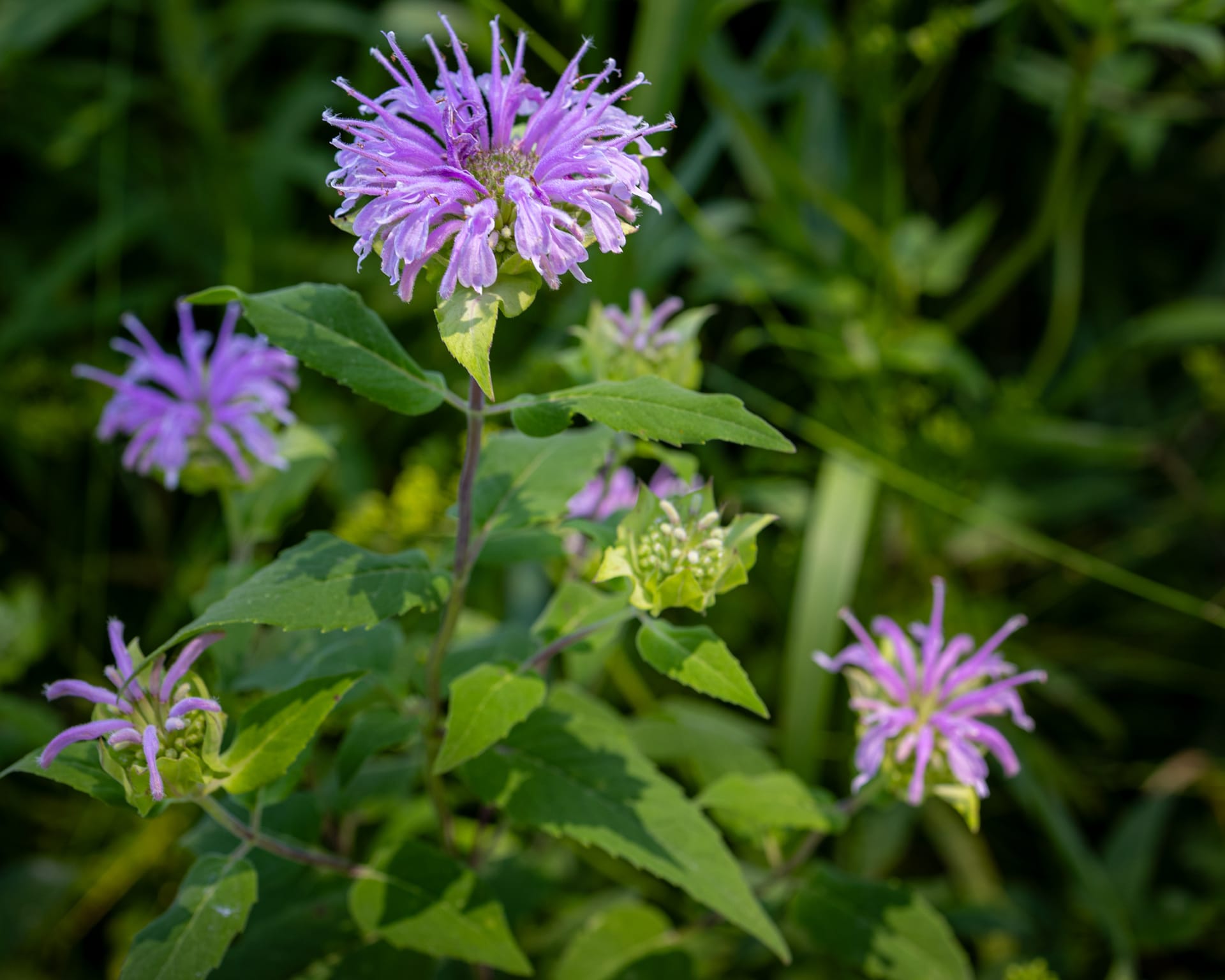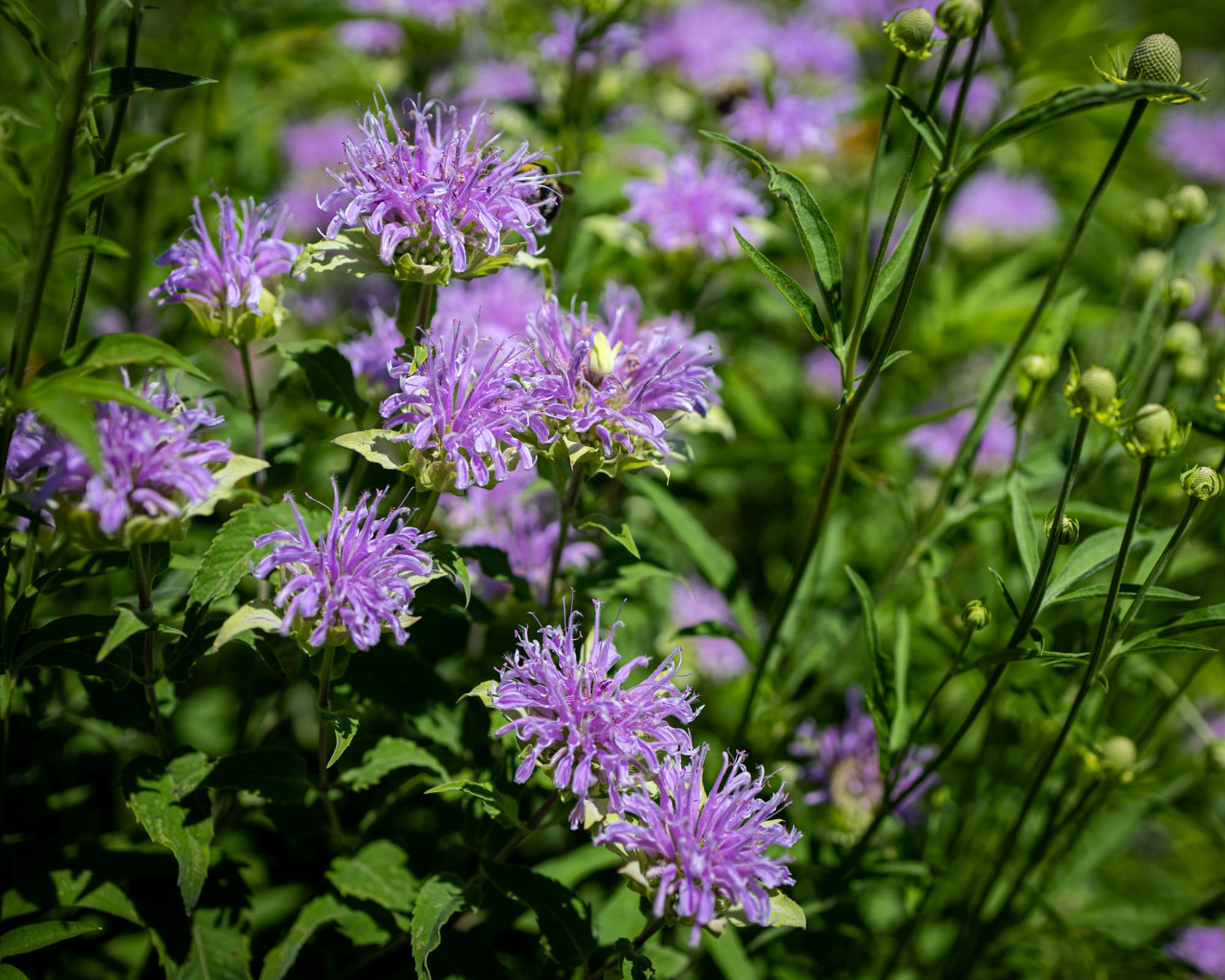Bee Balm

Basic Info
Range & Habitat
Bee Balm (M. fistulosa in particular) thrives in dry, open places like prairies, meadows, fields, or the sunnier and drier parts of oak savannas. You will find this plant mostly throughout the midwest, but will not likely find Monarda didyma in these parts unless intentionally cultivated.
M. punctata prefers alkaline, sandy soils where there is an abundance of sun. You often find M. punctata growing in dune areas where the sandy dunes have more soil stability near where the forest meets the dunes.

Botanical Description
Monarda fistulosa – A perennial mint that reaches a height of 1-4 feet. Square stem that is hairy at the nodes. Leaves are opposite, lanceolate, and coarsely toothed. The leaves grow to 3 inches long from short petioles. Tubular, inch-long lavender-purple flowers are clustered into dense, rounded heads at the ends of the stems, splaying out from the center.
Monarda punctata – Perennial mint growing up to 2 feet tall with a strong and erect square stem. Lanceolate leaves in opposite pairs, 2-4 in long, and covered with dotted glands on their undersides. The upper leaves are whitish to lavender in color. Flowers emerge in the axils of upper leaves in dense whorls and are yellow with purple speckles throughout. These flowers are surrounded by white to pale-purple leaf-like bracts.
Flora of the Chicago Region – Dichotomous Key for Monarda spp. [^ Gerould Wilhelm and Laura Rericha, Flora of the Chicago Region: A Floristic and Ecological Synthesis (Indianapolis: Indiana Academy of Science, 2017).]
- Corollas scarlet, more than 3cm long; bracts infused with scarlet = Monarda didyma
- Corollas neither scarlet nor 3 cm long; bracts green or infused with pink or lavender.
- Flower clusters in two or more axillary glomerules in an interrupted, spike-like inflorescence.
- Bracts acute, acuminate, or short-subulate, but never long-awned at the tip; flowers yellowish = Monarda punctata
- Flower clusters solitary and terminal at the tips of the flowering branches.
- Leaves distinctly petiolate, the larger petioles more than 0.5 mm long.
- Petioles often more than 2 cm long, sparesely villous, with spreading hairs mostly 0.5-1.5 mm long; corollas white to creamy = Monarda clinopodia
- Petioles less than 2 cm long, short-puberulent to canescent, with hairs all less than 0.3 mm long; corollas lavender = Monarda fistulosa
Harvesting Guidelines & Sustainability
Avoid plants with harsh, dry leaves and a more bitter flavor. You are looking for soft, oil-rich leaves with a sweet, slightly pungent taste with a bit of spicy heat. Pick at the height of flowering, about six inches above the root and dry for use in infusion or tincture.
Food & Nutritional Properties
Very similar in flavor to its European cousin, Oregano (Origanum vulgare). I will often use dried bee balm as a culinary spice in the same way I would use oregano. I will often mix the two together as a spice blend.
Medicinal Virtues & Applications
As one of the more warming aromatics, I consider Bee Balm to be an excellent calming nervine where stimulation or activation of the nervous system is required. It does an excellent job of 'heating up' and diffusing a nervous system state that resembles a cool damp thick layer of fog over the sensorium.
The diffusive nature of bee balm is also excellent in upper respiratory conditions, especially in instances of damp stagnation, where mucous seems to be stuck and can't flow. In this instance I often recommend a steam inhalation of bee balm (with other available aromatics thrown in if desired) to break up the mucous and regain flow.
According to Matthew Wood, Bee Balm excels where a client is presenting with seemingly 'paradoxical' tissue states. Bee Balm "is suited to cases where the skin is moist and cool, or clammy, but fever is burning away inside the organism. It will drive the heat to the surface and retain the fluids in the inside to cool and lubricate, thus reducing fevers and conditions characterized by a cool, clammy skin." [^ Matthew Wood, The Earthwise Herbal. A Complete Guide to New World Medicinal Plants (Berkeley, Calif: North Atlantic Books, 2009), 240-242.]
Matthew Wood also considers Bee Balm to be a 'curative agent' for Ménière's disease and tinnitus, and I have offered bee balm in combination with Ground Ivy as a tincture or tea for this very purpose.
Specific Indications
- Nervousness, anxiety
- Respiratory, digestive, or urinary concerns manifesting along with cool, clammy skin
- Difficulty living with or managing one's passions
- Deep nervous disorders
- Specific for tinnitus, Ménière's disease, poor hearing
- Bronchial asthma
- Irritable stomach
- Urinary tract infections
- High blood pressure that is associated with or exacerbated by anxiety or nervousness
- Leaky gut
- Candida
- Sunburn (flower tops as a spit poultice)
Preparation & Dosage
- Tea: prepare the dried leaves alone or with flowers as a hot infusion, consuming 8-12oz up to 3 times daily.
- Tincture: Fresh leaves & flowers (1:3, 80-95% alcohol); 1-2 ml up to 3x daily
- Spit Poultice: (for sunburn), chew the flowering tops and apply as a poultice to burned skin, wrapping to hold the flowers in place.
Safety Information & Cautions
Bee Balm contains high amounts of both thymol and carvacrol, and should avoided in pregnancy except under the supervision of a qualified healthcare practitioner.


Member discussion